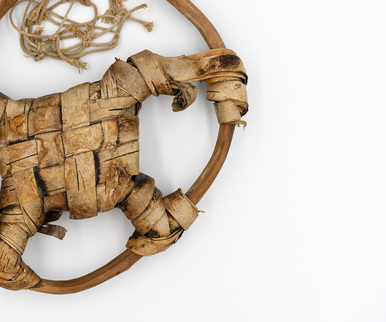The section “Life and Crafts of the Pomors” of the main exhibition of the Polyarny Museum of History and Local Lore presents a distaff. It was transferred to the museum by Clavdiya Ivanovna Devyatkina, a hereditary Pomor. The distaff belonged to her family and was kept in the family home.
The distaff or, as the locals call it, “pryalitsa” was made in the village of Varzuga in the late 19th — early 20th century from a single L-shaped piece of spruce tree cut at the conjunction of the trunk and the lateral root. It can be divided into two parts: a horizontal base and a vertical part. The vertical part is flattened and has holes. The holes are arranged vertically in a row. The holes are round and have a diameter of about 7 mm. When a woman was done spinning for the day, she inserted a spindle into one of the holes. The decorations on the spindle are not just for show, but also for fastening the silver. The base forms a right angle with the upper part. It expands at the tip which than narrows (tip dimensions: 0.7 by 9.5 cm). A silver (a bundle of flax, hemp or wool prepared for spinning) is attached to the vertical part of the distaff, from which the thread is pulled and spun using a spindle.
Yarn spinning was done by girls and women. The craftswoman pulled the fiber out of the silver with her left hand and twisted the spindle with the thumb and forefinger of her right hand. The thread was fixed with a special loop to the sharp spindle. It was then twisted and pulled to the right and slightly back until the spinner’s arm was fully extended. The spinner wound the fragments of the thread on her fingers and then put them on the spindle, after which the spinning process continued. Many Pomors, even in the 20th century, independently made distaffs for their loved ones from parts of birch, pine or spruce trees adjacent to the lateral root.
Every Pomor man who owned an
ax could make a distaff for his wife or daughter. Spinning on someone else’s
distaff was considered a bad omen among the Pomors. Girls usually learned to
spin not on the distaff of their mothers or grandmothers, but exclusively on
their own small distaffs. Every married Pomory woman had a personal distaff,
which she usually used throughout her life from
a young age.




